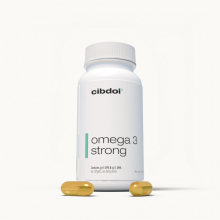Is Omega-3 Good for Breasts?
Published:
Omega-3 fatty acids like those found in fish oil provide a wide range of health benefits. But could optimizing omega-3 intake also support breast health? Some claim these essential fats may help reduce breast pain, balance hormones, and lower breast cancer risk. Let's objectively examine the evidence.
Contents:
- Overview of Omega-3 Fatty Acids
- Potential Breast Health Benefits of Omega-3s
- Evidence for Omega-3s and Breast Pain Relief
- Evidence for Omega-3s and Breast Cysts
- Evidence for Omega-3s and Breast Cancer Risk
- Evidence for Omega-3s Enhancing Breast Cancer Treatment
- Lifestyle Tips for Breast Health
- Is Omega-3 Good for Breasts? Conclusion

Overview of Omega-3 Fatty Acids
Before analyzing the effects on breasts, let's start with a brief overview of what exactly omega-3s are:
The Three Main Omega-3s
There are three primary omega-3 fatty acids that are important in the diet:
- ALA (alpha-linolenic acid)
- EPA (eicosapentaenoic acid)
- DHA (docosahexaenoic acid)
ALA comes from plant foods like flaxseeds and walnuts. EPA and DHA come mainly from fatty fish and fish oil.
Essential for Health
Omega-3s are termed “essential” fatty acids because the body cannot produce them. We must obtain them from food or supplements for proper health.
They are critical for neurological function, vision, pregnancy, metabolism, growth, and reducing inflammation.
Anti-Inflammatory Properties
A major reason omega-3s provide benefits is their ability to resolve chronic inflammation in tissues. EPA and DHA in particular are potent anti-inflammatories.
Now that you have some background on omega-3s, let's analyze how they may promote breast health.
Potential Breast Health Benefits of Omega-3s
Here are some of the top ways omega-3 fatty acids may support breast health and reduce risk factors:
1. Reducing Breast Pain
Studies show supplemental omega-3s from fish oil can decrease breast tenderness and pain in women with cyclic mastalgia. The anti-inflammatory effects likely underlie benefits.
2. Improving Breast Cysts
Fish oil supplementation has been reported to help resolve breast cysts in some women with fibrocystic breast disease. Again, reducing inflammation is likely the mechanism.
3. Balancing Hormones
The anti-inflammatory benefits of omega-3s may also help regulate estrogen metabolism and temper estrogen's stimulatory effects on breast tissue.
4. Lowering Cancer Risk
Higher omega-3 intake or blood levels are associated with reduced risk for developing breast cancer. DHA may be particularly protective.
5. Improving Chemotherapy Response
Some research indicates omega-3 supplementation can heighten tumor sensitivity and response to chemotherapy drugs used to treat breast cancer.
Let's explore the evidence behind each of these potential benefits in greater detail:
Evidence for Omega-3s and Breast Pain Relief
One of the most consistent findings regarding omega-3s and breasts is reduction of breast pain:
- Multiple studies show fish oil supplements providing 1-3 grams EPA/DHA daily significantly reduce breast tenderness and pain intensity compared to placebo.
- Up to a 60% decrease in self-reported pain has been noted with omega-3 supplementation.
- Effects may depend on achieving adequate blood levels of EPA/DHA. Higher intakes may provide greater relief.
- The anti-inflammatory effects likely reduce local swelling, nerve pain signaling, and muscle contractions causing breast pain.
- Omega-3s provide a safe, natural alternative to medications like tamoxifen for alleviating cyclic or non-cyclic breast pain.
Overall, there is convincing evidence that omega-3s can provide relief for breast pain associated with menstrual cycles, fibrocystic changes, or unknown causes.
Evidence for Omega-3s and Breast Cysts
In addition to breast pain, omega-3 intake may also help improve breast cysts:
- Several studies have reported reductions in breast nodularity and cyst symptoms in women with fibrocystic breast disease after fish oil supplementation.
- Up to a 50% decrease in self-reported nodularity and lumps has been noted.
- Thermography scans also showed decreases in cystic patterns and areas of inflammation/congestion.
- Some individuals experienced complete dissolution of cysts and fibroadenomas while taking omega-3s.
- The anti-inflammatory and hormone balancing effects likely contribute to reversing cystic breast changes.
The research specifically on breast cysts is limited, but the results are promising for non-invasive cyst relief.
Evidence for Omega-3s and Breast Cancer Risk
Omega-3 intake may also reduce risk for developing breast cancer:
- Population studies show higher blood levels or dietary intakes of omega-3s are associated with 10-25% lower incidence of breast cancer.
- However, some randomized trials supplementing omega-3s in healthy women showed no protective effects on breast cancer rates compared to placebo groups.
- Early animal research demonstrated omega-3s inhibit tumor growth and metastasis. But human trials are mixed.
- More research is still needed on optimal dosing strategies for cancer risk reduction. Intakes ≥2 grams EPA/DHA appear most promising.
While omega-3s show potential for lowering breast cancer risk, more clinical evidence is still needed to make conclusive determinations.
Evidence for Omega-3s Enhancing Breast Cancer Treatment
Emerging research shows promise for omega-3s improving response to conventional breast cancer therapies:
- Omega-3 intake changes cell membranes to improve chemotherapy drug uptake into tumors in animal models.
- Women with breast cancer taking ~2 grams daily EPA/DHA alongside chemotherapy had higher tumor sensitivity and response rates in some trials.
- However, not all human trials demonstrate benefit. More research is underway.
- Animal studies also show omega-3s may make cancer cells more susceptible to radiation therapy. Human studies are needed.
- Omega-3s may also help protect healthy cells from collateral chemotherapy/radiation damage.
The research on omega-3s enhancing cancer treatments shows initial promise but is still developing. More evidence is required to make firm recommendations.
Lifestyle Tips for Breast Health
While optimizing omega-3 intake may benefit breast health, many other lifestyle factors play important roles as well:
- Maintain a healthy body weight - Obesity increases risk for breast pain, cysts, and cancer.
- Exercise regularly - Physical activity helps balance hormones and lower breast cancer risk.
- Limit alcohol intake - Drinking alcohol raises estrogen levels and breast cancer risk.
- Don't smoke - Smoking impairs estrogen metabolism and significantly increases breast cancer risk.
- Breastfeed if possible - Breastfeeding lowers estrogen exposure of breast tissue over a lifetime.
- Avoid hormone disrupting chemicals - From plastics, cosmetics, cleaning products, etc.
- Reduce stress - Chronic stress disrupts hormone pathways that can affect breast tissue.
Adopting an overall healthy lifestyle provides the most robust breast health benefits. Omega-3s may serve as a complementary component of broad wellness strategies.
Is Omega-3 Good for Breasts? Conclusion
Current evidence suggests omega-3 EPA and DHA may support breast health by:
- Alleviating breast pain and tenderness
- Helping improve breast cysts and nodularity
- Balancing hormone levels that stimulate breast tissue
- Possibly lowering risk for developing breast cancer
- Enhancing tumor sensitivity and treatment response
However, more clinical research is still warranted, especially on the cancer prevention and treatment effects.
Omega-3 intake alone is unlikely to be a cure-all. But as part of an overall healthy lifestyle, optimizing omega-3 status may provide additive benefits for maintaining breast health and reducing associated risks.















